Reflections on retail design and the minimalist intent: brand and reflectivity in experience design, community and place.
Since I’ve worked in the space of retail design for about 30 years, I’ve been long exploring the idea of design that relates to space.
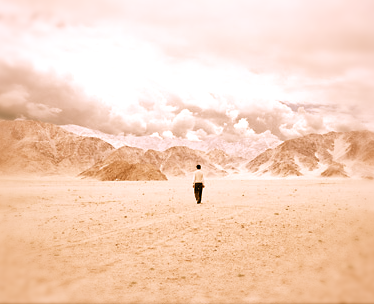
© 2008 | NYTimes
And place. And sometimes: the sense of place, in space.
I contemplate that, the idea of place. What is place? What does that mean, where does that come from?
Here’s examining that idea — place, etymologically:
place (n.)
O.E. “open space in a city, market place, square,” from O.Fr. place, from M.L. placea “place, spot,” from L. platea “courtyard, open space, broad street,” from Gk. plateia (hodos) “broad (way),” fem. of platys “broad,” from PIE *plat- “to spread” (cf. Skt. prathati “spreads out;” Hitt. palhi “broad;” Lith. platus “broad;” Ger. Fladen “flat cake;” O.Ir. lethan “broad”); extended variant form of base *pele-.
Consider the root, the beginning — which would be the (PIE) Proto-Indo-European etymon. Dictionary etymological references go backwards, starting with the most recent usage notation. So the first reference is the most recent — O.E. = Old English. Then they go back, and back, traced through time (http://en.wikipedia.org/wiki/Proto-Indo-European_language). What I look for is the heart of the word — and that relates to, literally, a “spread”. But what I take from that is the arrangement in space of something that is spread out, like a broad expanse, a planar expression, a plain. What that sense relates to, for me, is that space | place, is like a mirror — you bring to this expanse what you reflect back. In that context of reflection, place becomes something that is yours — it’s what you bring to it. Either as a designer, or a person simply exploring, you bring something. And surely you bring something to your experience. And you take something away. That’s the sense of place — in space.
For me at least.
I’ve talked about this with some other designers, theorists, leaders and place-makers. They’ve offered these contemplations:
Philippe Soussand | Luxury retail and branding strategist (http://www.soussandgroup.com/):
“A meaningful place to me stimulates my senses! Could be by amazing me, pleasant fragrances, views and or sounds…”
Dr. Joseph Riggio |Corporate visioning and leadership consultant (http://www.josephriggio.com/):
“Ultimately for me place exists in the visceral resonance to the melange of the full sensorial pattern present … drawing into myself the sights and sounds, and their interplay … breathing in deeply of the space and its flow, including the nooks, crannies and cramped spaces contained by the dome of the space-at-large … and most of all triggering a deep, primal visceral response that positions me as a unique player… attuning to the greater workings that surround me are the smells of the place … and of its people … always I know what airport I’ve landed in, or what city I am walking through, whether there is a fit “here” for me, or not … from the very first scent …”
Dawn A. Clark, AIA, LEED® AP:
“The retail places I love are the ones that are authentically rich. I think maybe it’s because they are true reflection of the people’s culture, created by the hands of the merchants and shoppers, organically grown over time – they embody a culture, place and time of a community. I think of the Grand Bazaar and spice markets in Istanbul, the Milan Galleria, Takashita street in Harajuku, Tokyo, the Pike Place Market, Seattle. Modern retail places that have some of this power, magic, are rare. The typical mall, department store, and brand flagship all feel fabricated, hollow — no sense of place, no rich scents, they are vanilla enclosures lacking any sense of proportion or beauty, no texture, no layers of time.”
Scott Williams | Chief Creative Officer | Morgans Hotel Group (http://www.morganshotelgroup.com/):
“Place is just space without detail (emotional reason or facts). The road is a road is a road, unless Cormac McCarthy writes it. Space becomes special (meaningful?) when some spectrum of emotion(s) have been tapped. An experience is extraordinary when it has transformed me or modified my behavior in some dimension and I am never the same (person).”
Lisa Picard:
“What I think brings meaning to place is the innate emotion a place can resonate, evoke or awaken within our soul. It has more to do with experience as defined by our anticipation of the place, then the experience of place and finally the reception or the place’s ability to leave us with a lasting memory of it and thus the ability to carry it forward in story. I think a place can be meaningful when its uncomfortable too, yet those aren’t necessarily something we seek in a commercial sense, but ok for public spaces (and sometimes necessary).”
James Simkins | Principal | MTM Luxury Lodging (www.mtmluxurylodging.com):
“A place is special … has some form of emotion attached to it, obviously positive is desirable. A place is also a destination … somewhere we can define in terms of its physical attributes (either positive or negative). So, a place has a personality, makes an impact, is memorable, tells a story…”
Claudia Cividino | CEO | AdamLippes (http://www.shopadam.com/):
“All the best brands in the world have created a sense of place no? Even if you don’t travel to a specific place to buy the product. We all know what the inside of a Starbucks or a Whole Foods looks like, and some of us find comfort in that sameness, but what about peanut M&M’s they are a brand with a distinctive ‘place’ in our psyche, not in a physical form. All of this to say that for me place is a rememberance. When I walk into a fantastic new hotel, I connect to it because it reminds me of something, somewhere I’ve been, a place I’ve seen in a movie, TV, or in my mind in a book…… It’s a remembrance of what I have experienced in the past which touched me.”
Song Pak | Managing Director | AMM Asset Development | Seoul:
“Temporal world…transition place. My sense of placeness constantly changes living in two different world…seattle and seoul. A placeness is spiritual…being with the people you love and being able to move back and forward..trsnsporter. I feel as if I’m in the futuristic world where everything changes so much faster in Seoul. A placeness is the defined by the rate of change with your perception of speed.”
Arnold Shain | Founder | Restaurant Group, Inc. (http://www.restaurantgroup.com/):
“What makes place, for dining? — I think it is the attitudinal tone of the staff. This starts with ownership / executive management. If they manage from the spot of making the staff feel important and welcomed, then the staff will follow this lead and do the same toward the guest. I learned that, from those activities within the operation, it gives people a reason to hang out and come back for a variety of reasons. It is almost club-like in the sense that there is a feeling of belonging to something. That creates place. Same people day in and day out because of the above elements.”
Lee Horswill | Creative Director | Ameristar Casinos (http://www.ameristarcasinos.com/): “Connectivity to the space via the all senses, touch, smell, sound, is one of the most important and often overlooked pieces of place-making; Mere visual FF&E design is like a wine without a story. Nice to sip, but is quickly forgotten. “Quality is remembered long after the price is forgotten” — Gucci family motto.
Tyler Heiden Jones | Luxury Brand Leadership & Marketing Consulting @ The Abbey:
“Personal space as reflected by artifacts and collectables of one’s travels, creations, gifts and memorabilia. Personal space evolves over time as a reflection of one’s history, our journey through life, acting as the biographer.”
To the concepts of minimalism — I’ve always found that ethos of design to be a little confusing. But perhaps this concept holds, for example, when you consider the concept of reflectivity.
What these sentiments express, each one of them, is the idea of the memorability of experience — that is, what in our lives are potently memorable — and what comes back to us? What do we hold? And when we go somewhere, it’s what we bring that supports in empowering the space. And makes place.
What then about a place that might not be perceived to have much of a personality, let alone a story, and perhaps, significantly, a very “recessive” brand and positioning? How does that work? Aloha Rag and the minimalist sensitivity is a good case in point.
What’s the story here? http://www.nytimes.com/aloha-rag
Beyond that, really, what is the story – textually, visually, narratively, or otherwise?
I dug in.
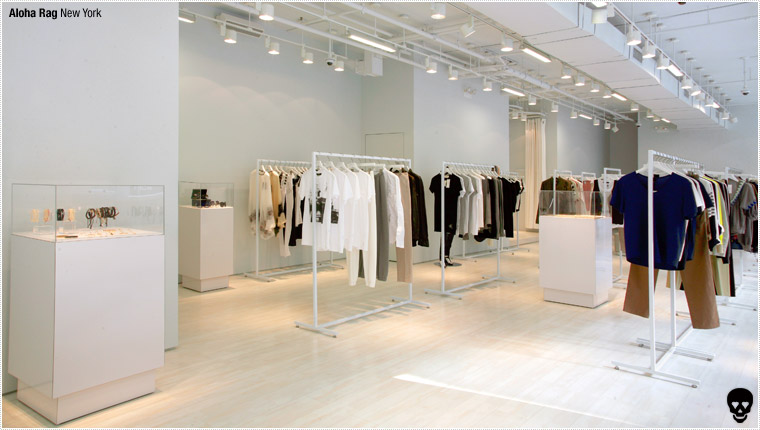
Clean, minimalist, spectacularly restrained. But reflective? What is you is what you get, what you give is what you get back, what you see is what you get. What more? Perhaps so.
Mike Albo references, in the NYTimes, June 5, 2008 —
“I recommend visiting the new hipster high-end clothing store Aloha Rag as soon as possible, because it’s in the dead center of a freshly gentrified neighborhood that is about to become the city’s next overhyped fashion and night life destination. The store is on Spring and Greenwich, right above Canal Street, where polished, glassy condos have been hoisted up, fussy restaurants and cafes have settled in. And this gleaming store will soon be joined by spaces for the sublime designer Rick Owens and the sophisticated boutique Atelier.” The retail modeling is about price. High prices, in the most minimalist and restrained setting. Albo: “Aloha Rag’s basement space is shiny, white and filled with light. The room is divided between women’s and men’s selections, with shelves under the large windows displaying accessories and shoes. Clothes dangle from the racks on shiny metal hangers, spaced meticulously equidistant from one another, making them all look precious and expensive, which they are. A dark sweater by a Singapore-born designer named Rivy Ng was cut like a tuxedo jacket with tails ($1,063). A cute lightweight blue cardigan by the brand 5+1 Annapurna was $550.”
Actually, there’s much to be confused by, in the conception of the store, which began in Honolulu, founded by a Japanese merchant. But perhaps, white, light, shininess are all about that opening recollection: reflection.
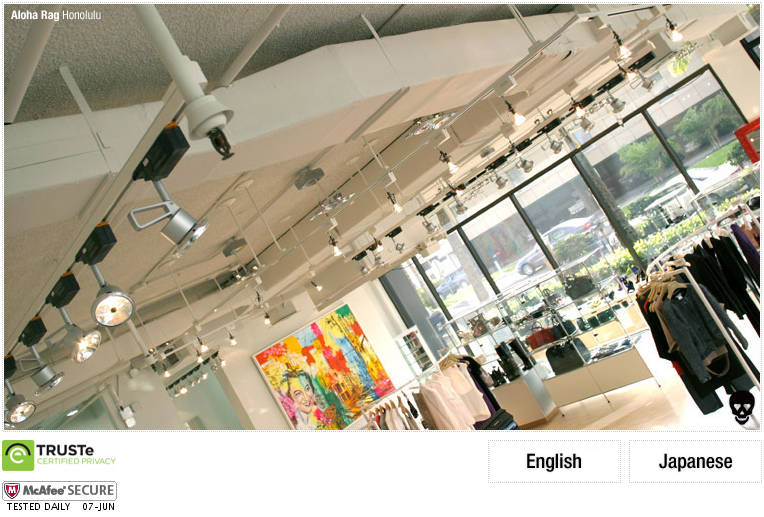
The naming strategy — Aloha Rag is rather conflicted, since the clothing is nearly Hawaiian, cheap or ragged. The concept derives from the original Aloha Rag which in the 90s sold only vintage clothing when it opened in Honolulu.
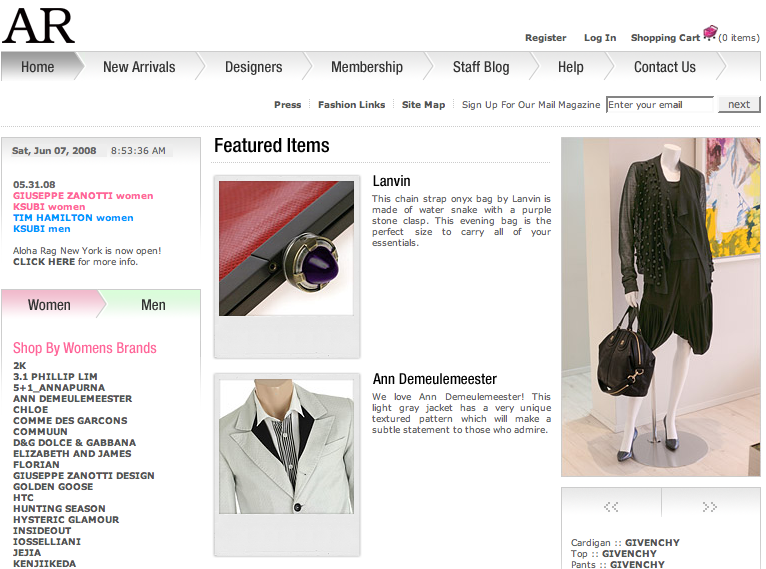
The founder, Tatsugo Yoda, diverged his strategy when he began offering luxury brands side by side with his surfside vintage selections. As one of the contributors to the site, he blogs on largely personal reflections:
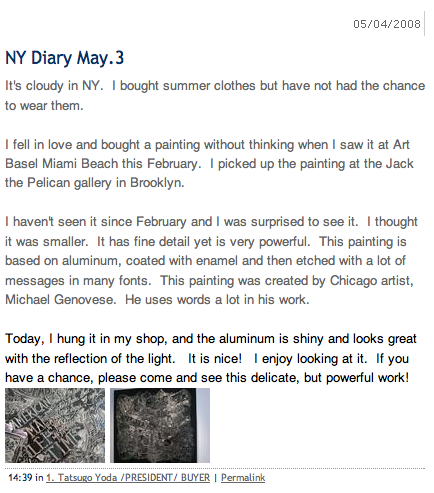
After he was introduced to Martin Margiela’s gorgeous clothing, he shifted his offerings strategy. For style bound Hawaiians, the Honolulu location now carries the likes of Balenciaga, Alexander McQueen and Chloé.
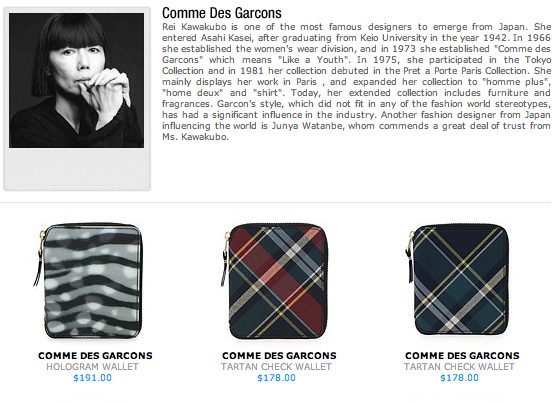
The matching, restrained website, according to the NYTimes is “immensely popular”. How, I’m not sure — but it’s the merchandise, certainly. The New York store, which opened in April, will feature new designers and exclusives with lesser known lines, including Jejia, Majik and distantly obscure Japanese labels like Garment House Mania, KenjiIkeda and Foundation Addict.
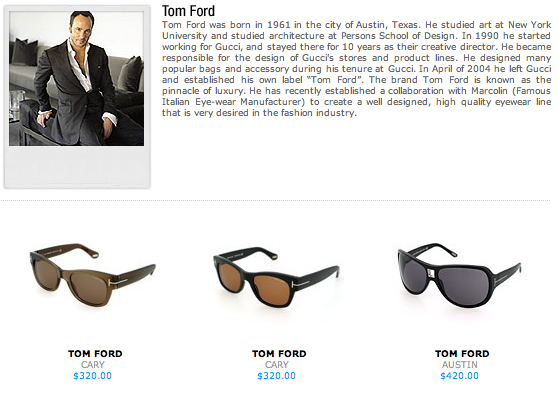
ALOHA RAG’S evolution, and new invention, from a secondhand clothing shop into a high-end fashion destination, “is yet another example of the zealously chic age we live in, when a $285 baseball hat in a rainbow metallic print (available here from Majik) seems like a completely normal thing to buy, even if you can’t afford your health insurance payment.” (Albo)
I looked for some reference here, and I can’t seem to find the symbolism, skull, corner bound, on the site.
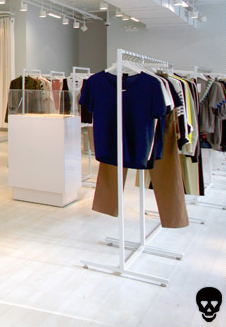
Might be something here, perhaps (http://blog.girvin.com/girvin-skull-flame/)
What’s your take? Minimalist maximalism?
Let me know. I’ll stand by. Waiting, my place.
tsg | NYC + Seattle